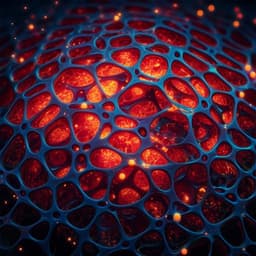
Chemistry
Direct regeneration of degraded lithium-ion battery cathodes with a multifunctional organic lithium salt
G. Ji, J. Wang, et al.
Unlock the potential of spent lithium-ion batteries! This groundbreaking research by Guanjun Ji, Junxiong Wang, Zheng Liang, Kai Jia, Jun Ma, Zhaofeng Zhuang, Guangmin Zhou, and Hui-Ming Cheng demonstrates how a multifunctional organic lithium salt revitalizes degraded LiFePO4 cathodes, showcasing remarkable cycling stability and rate performance. Discover how this innovative approach outperforms traditional recycling methods.
~3 min • Beginner • English
Introduction
Lithium-ion battery manufacturers seek higher energy density and safety. LiFePO4 (LFP) batteries are widely deployed due to stability, long life, and pack-level innovations, which increases volumes of spent cells. Conventional end-of-life recycling includes pyrometallurgy, hydrometallurgy, and direct regeneration. Pyro-routes require high-temperature smelting and high energy; hydro-routes consume strong acids/alkalis and involve many purification steps. For degraded LFP, lithium is the principal valuable element, diminishing the economic appeal of pyro/hydro approaches. Capacity fade in LFP mainly stems from lithium loss, which forms Fe(III) (FePO4) and induces Li–Fe anti-site defects, and from degraded/fragmented surface conductive carbon that impairs charge transport and rate capability. Direct regeneration aims to restore composition and structure of spent cathodes. Prior direct methods show that lithium replenishment and a reductive environment are critical, and that sluggish electronic/ionic transport remains a limitation. Inorganic lithium salts (e.g., Li2CO3, LiOH, Li2SO4) can supply Li but are monofunctional and do not provide reducing or carbon sources, necessitating extra additives. The study proposes a multifunctional organic lithium salt, 3,4-dihydroxybenzonitrile dilithium (Li2DHBN), that can simultaneously: supply lithium to fill vacancies, create a reductive atmosphere via cyano groups to suppress Fe(III), and pyrolyze into a uniform conductive carbon coating to restore electron/Li-ion transport, thereby directly regenerating degraded LFP and potentially other cathodes.
Literature Review
Existing recycling strategies include pyrometallurgical and hydrometallurgical routes, which are energy- and reagent-intensive and less economical for LFP where lithium is the main value carrier. Direct regeneration has been demonstrated via targeted healing, prelithiated separators, molten salt processes, and hydrothermal routes, emphasizing the need for Li replenishment and a reducing environment to reverse FePO4 to LiFePO4. Coating LFP with conductive agents (carbon, conducting polymers) is known to enhance rate and low-temperature performance, but carbon coatings can degrade over long-term cycling, disrupting electronic networks. Inorganic lithium salts (Li2CO3, LiOH, Li2SO4) used in direct regeneration supply lithium but lack reductive/carbon functionalities, often requiring additional reducing/carbon sources. Prior work also highlights Li–Fe anti-site defects as diffusion bottlenecks along [010], limiting kinetics and rate capability. These gaps motivate a single reagent that provides lithium, reduction, and conductive recoating.
Methodology
Synthesis of Li2DHBN: Following prior work, 1 g 3,4-dihydroxybenzonitrile was dissolved in 30 mL anhydrous tetrahydrofuran at room temperature and stirred 10 min. Then 0.118 g lithium hydride was added in a glove box. The mixture was stirred 15 h to yield a yellow solution. After filtration, the Li2DHBN precipitate was dried at 150 °C under vacuum for 6 h. The process proceeded at room temperature without extra heating or polluting gases.
Regeneration of LiFePO4 (R-LFP): Spent LFP cathode powder (S-LFP) was mixed with Li2DHBN and ground 15 min (agate mortar). The mix was heated at 5 °C min−1 to 800 °C and sintered 6 h under Ar/H2. Single-factor studies determined optimal Li2DHBN amount (5 wt%) and temperature (800 °C). For comparison, Li2CO3 and LiOH were used under identical conditions. For LiCoO2 (R-LCO) and LiNi0.8Co0.15Mn0.05O2 (R-NCM), mixtures were heated in a muffle furnace: 5 °C min−1 to 500 °C for 5 h, then to 800 °C for 10 h, under similar conditions.
Characterization: ICP-OES for elemental composition; XPS for surface valence (Fe 2p and surveys); XRD (Cu Kα, 2θ = 10–80°) for phases; FESEM and HRTEM for morphology/microstructure; TG-FTIR for Li2DHBN thermal decomposition and evolved species; temperature-dependent XRD from 30–800 °C (5 °C min−1, hold 1 h at 800 °C) for in situ phase evolution; EELS (O K-edge, Fe L2,3-edges) for valence/phase mapping at single-particle scale; EDS mapping for elemental distributions.
Electrochemistry: Electrodes composed of active material:acetylene black:PVDF = 8:1:1 in NMP, coated on Al foil, dried at 60 °C for 12 h, loading 2–3 mg cm−2. CR2032 half-cells assembled in Ar glove box with Li metal counter, Celgard2325 separator, and 1.0 M LiPF6 in EC:DMC:DEC (1:1:1 v/v) electrolyte. Galvanostatic tests on NEWARE testers within 2.5–4.3 V vs Li/Li+. CV and EIS using BioLogic SP-150e; in situ EIS collected at multiple voltages during first cycle. GITT used to estimate Li+ diffusion coefficients.
Techno-economic and environmental analysis: Process-based cost and revenue models compare hydro-route (sulfuric acid leaching reference) and direct route for processing 1 ton of degraded LFP batteries yielding ~250 kg degraded LFP powder. Costs split into raw material, reagent, labor, utilities, equipment depreciation, sewage treatment. Residual lithium content in degraded LFP (x in LiFePO4) treated as a critical factor affecting reagent consumption (direct route) and Li2CO3 revenue (hydro-route). EverBatt 2020 model (Argonne) underpins life-cycle energy use and GHG emissions for pyro-, hydro-, and direct routes; direct route materials/energy based on lab data. Components like separator/electrolyte/shell excluded from revenue estimates due to valuation uncertainty.
Key Findings
- Structural/compositional restoration: ICP-OES shows Li deficiency in S-LFP corrected in regenerated materials. XPS Fe 2p for R-LFP-Li2DHBN shows Fe(II) with no Fe(III) signal; in-depth XPS indicates surface-to-bulk elimination of FePO4. XRD confirms disappearance of FePO4 phase post-regeneration. Rietveld refinements: S-LFP contains 21.3% FePO4 and 78.7% LiFePO4 with Li–Fe anti-site 2.4%; R-LFP-Li2DHBN eliminates FePO4 and reduces anti-site defects to 1.2%.
- Carbon recoating: HRTEM/EDS reveal a uniform amorphous carbon coating (4–5 nm) on R-LFP-Li2DHBN particles, derived from Li2DHBN pyrolysis; S-LFP and R-LFP-Li2CO3 show nonuniform or missing surface carbon.
- Thermal/phase mechanism: TG-FTIR indicates Li2DHBN decomposes through multistage formation of Li2CO3 and hydrocarbons; above ~700 °C Li2CO3 decomposes to Li2O, providing Li+ for vacancy filling. In situ XRD shows three stages: Stage I reduction of Fe(III)/FePO4 (disappearance of 2θ ≈ 18.1°, 30.9°), Stage II Li insertion with peak shifts to lower angles and lattice volume increase, Stage III structural stabilization.
- Electrochemical performance: At 0.1 C, discharge-specific capacities: S-LFP 102 mAh g−1; R-LFP-Li2CO3 146; R-LFP-LiOH 152; R-LFP-Li2DHBN 157 mAh g−1. Initial CV polarization ΔV: Li2DHBN 206 mV vs Li2CO3 218 mV and LiOH 316 mV. Li+ diffusion: higher slopes in Randles–Sevcik plots and higher GITT-derived DLi for Li2DHBN, indicating cleared diffusion barriers. Rate capability: S-LFP 98/91/79/68 mAh g−1 at 1/2/5/10 C; R-LFP-Li2DHBN achieves 127/111/97 mAh g−1 at 2/5/10 C. Low-temperature: retains 61 mAh g−1 at −20 °C; stable cycling at ≥40 °C. Long-term at 5 C: 110 mAh g−1 with 88% capacity retention after 400 cycles, outperforming Li2CO3 (73 mAh g−1) and LiOH (77 mAh g−1). Even at 10 C, Li2DHBN shows superior stability. In situ EIS: reduced Rct for R-LFP-Li2DHBN vs S-LFP across discharge; RΩ stable.
- Single-particle spectroscopy: EELS mapping of S-LFP shows surface-enriched Fe(III)/FePO4 regions and inhomogeneous LFP/FP distribution; R-LFP-Li2DHBN shows constant Fe(II) signatures and absence of O K-edge pre-edge, evidencing restored Li and elimination of Fe(III).
- Generality: Li2DHBN also regenerates degraded LiCoO2 and LiNi0.5Co0.2Mn0.3O2 cathodes.
- Techno-economic/environmental: For x = 0.8 in LiFePO4, profits: direct route ≈ 2,556 $ ton−1 vs hydro-route ≈ 945 $ ton−1. Direct route revenue dominated by restored LFP (~79%). Energy consumption: pyro 12.14, hydro 19.57, direct 3.16 MJ kg−1 cell. GHG emissions: pyro 1.96, hydro 1.49, direct 0.59 kg kg−1 cell. Direct route shows cost, energy, and GHG advantages and higher product value.
Discussion
The multifunctional organic lithium salt Li2DHBN addresses the principal degradation mechanisms of LFP: lithium loss and Fe(III) formation, and deterioration of the conductive carbon network. Its cyano-containing framework couples to particle surfaces at low temperature and, upon heating, supplies lithium (via Li2CO3→Li2O) to fill vacancies and establishes a reductive atmosphere that converts Fe(III)/FePO4 back to Fe(II)/LiFePO4. Simultaneously, pyrolysis forms a uniform amorphous carbon coating that restores electronic pathways and enhances Li+ transport. These coupled compositional, structural, and interfacial restorations eliminate Li–Fe anti-sites and improve reaction kinetics, yielding higher capacities, superior rate performance, robust low-temperature operation, and long-cycle stability. The approach generalizes to layered oxide cathodes, suggesting broad applicability. Techno-economic and life-cycle analyses indicate that direct regeneration with Li2DHBN provides greater profitability and lower energy/GHG footprints than hydro- and pyro-routes, owing to simplified processing and high-value outputs. Collectively, the findings validate a one-step, multifunctional reagent strategy for sustainable cathode regeneration.
Conclusion
This work demonstrates that a multifunctional organic lithium salt (Li2DHBN) enables one-step direct regeneration of degraded LFP by simultaneously supplying lithium, creating a reductive environment to eliminate Fe(III)/FePO4 and reduce Li–Fe anti-site defects, and forming a uniform conductive carbon coating. The regenerated LFP achieves 157 mAh g−1 at 0.1 C, excellent rate capability (up to 97 mAh g−1 at 10 C), and long-term stability (110 mAh g−1 with 88% retention after 400 cycles at 5 C), along with improved low-temperature performance. The method extends to other cathodes (LiCoO2, LiNi0.5Co0.2Mn0.3O2). Techno-economic and environmental assessments highlight superior profitability and reduced energy/GHG impacts relative to conventional hydro-/pyro-recycling, underscoring the industrial promise of direct regeneration. Future work should optimize regeneration for highly degraded cathodes, integrate logistics (collection, classification, transportation) into economic models, and develop generalized protocols adaptable to diverse chemistries and degradation states for large-scale deployment.
Limitations
Scaling challenges remain: (1) Solid-state direct regeneration of highly degraded cathodes may be difficult and requires further optimization. (2) The techno-economic model, while indicative, does not fully incorporate practical factors such as collection, sorting, and transportation of spent cells; some component values (separator, electrolyte, shell) were excluded due to uncertainty. (3) A universal recovery process suitable for various cathode chemistries and degradation levels is still needed for real-world implementation.
Related Publications
Explore these studies to deepen your understanding of the subject.







